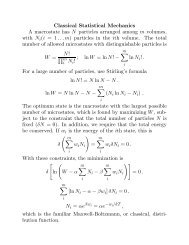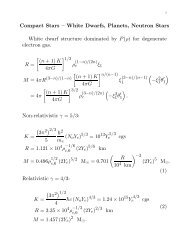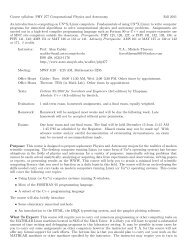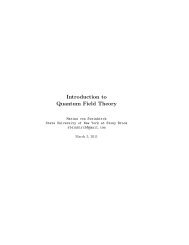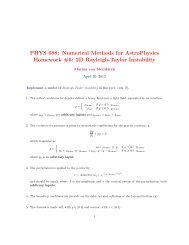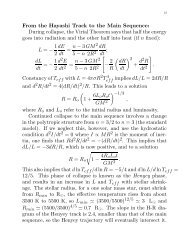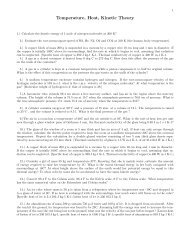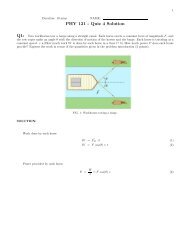On the study of the Potts model, Tutte and Chromatic Polynomials ...
On the study of the Potts model, Tutte and Chromatic Polynomials ...
On the study of the Potts model, Tutte and Chromatic Polynomials ...
Create successful ePaper yourself
Turn your PDF publications into a flip-book with our unique Google optimized e-Paper software.
chromatic polynomial was to show that for planar graphs, P G (x) > 0, for x > 3. If G is<br />
an n-vertex graph <strong>the</strong>n P G (z) has degree n <strong>and</strong> so this equation has n solutions over <strong>the</strong><br />
complex numbers. Fundamental questions are related to <strong>the</strong> search for absolute bounds on<br />
<strong>the</strong> root-location <strong>and</strong> <strong>the</strong> search <strong>of</strong> this bounds in terms <strong>of</strong> graph parameters [2].<br />
No graph can be 0-colored, so 0 is always a chromatic root. <strong>On</strong>ly edgeless graphs can be<br />
1-colored, so 1 is a chromatic root for every graph with at least an edge. <strong>On</strong> <strong>the</strong> o<strong>the</strong>r h<strong>and</strong>,<br />
except for <strong>the</strong>se two points, no graph can have a chromatic root at a real number smaller<br />
than or equal to 32/27. This comes from a result <strong>of</strong> <strong>Tutte</strong>, connecting <strong>the</strong> golden ratio with<br />
<strong>the</strong> <strong>study</strong> <strong>of</strong> chromatic roots. He showed that if G is a planar triangulation <strong>of</strong> a sphere <strong>the</strong>n<br />
P (G n , φ) ≤ φ 5−n .<br />
Later, Farell observed that some zeros are more “popular” than o<strong>the</strong>rs, specifically <strong>the</strong><br />
sequence {3/2 ± i √ 3/2, 2 ± i, 5/2 ± i √ 3/2, ...} [2].<br />
For many years, it was thought that chromatic zeros were restricted to <strong>the</strong> right halfplane<br />
Re(z) > 0. In 1999, Alan Sokal proved that chromatic zeros are dense in <strong>the</strong> whole<br />
complex plane [10] [36].<br />
While <strong>the</strong> real line thus has large parts that contain no chromatic roots for any graph,<br />
every point in <strong>the</strong> complex plane is arbitrarily close to a chromatic root in <strong>the</strong> sense that<br />
<strong>the</strong>re exists an infinite family <strong>of</strong> graphs whose chromatic roots are dense in <strong>the</strong> complex<br />
plane.<br />
In <strong>the</strong> case <strong>of</strong> complex zeros, generalized <strong>the</strong>ta graphs are graphs with two end points<br />
connected via paths <strong>of</strong> varying lengths. Sokal also analytically proved that all <strong>the</strong> chromatic<br />
roots <strong>of</strong> <strong>the</strong>se graphs lie within a certain disc [10].<br />
Recently, progress has been made in <strong>the</strong> <strong>the</strong>ory <strong>of</strong> zeros <strong>of</strong> recursive families (recall from<br />
Definition I.6 that a sequence <strong>of</strong> graphs {G 1 , ..., G m } is a recursive family if P (G m , m) =<br />
f(P (G m−1 ), ..., P (G 1 )), where f is some simple linear function). <strong>Chromatic</strong> zeros <strong>of</strong> recursive<br />
families <strong>of</strong> graphs obey a limiting process <strong>and</strong> Shrock <strong>and</strong> Tsai [11] proved that a certain<br />
family <strong>of</strong> graphs have zeros lying on circles <strong>and</strong> relate <strong>the</strong> results to a certain <strong>Potts</strong> <strong>model</strong><br />
(described in <strong>the</strong> next session). This paper provides an interesting link between chromatic<br />
zeros <strong>and</strong> <strong>the</strong> <strong>Potts</strong> <strong>model</strong> on a certain class <strong>of</strong> graphs.<br />
8



